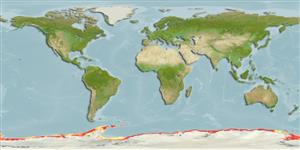>
Perciformes/Notothenioidei (Icefishes) >
Nototheniidae (Cod icefishes) > Trematominae
Etymology: Trematomus: Greek, trematos = hole + Greek, tomo = section, cut (Ref. 45335); scotti: Named after Captain Robert Falcon Scott, leader of British National Antarctic Expedition (Ref. 11892).
Eponymy: Robert Falcon Scott (1868–1912) was a British naval officer and Antarctic explorer. His biographies are extensive, so need not be repeated here. (Ref. 128868), visit book page.
More on author: Boulenger.
Issue
The genus Pseudotrematomus is a synonym of Trematomus, which is confirmed by a molecular study to be published (J.-C. Hureau, pers. comm. 08 Jun. 2010).
Environment: milieu / climate zone / Tiefenbereich / distribution range
Ökologie
seewasser demersal; tiefenbereich 20 - 793 m. Polar; 60°S - 78°S
Southern Ocean: South Shetland, South Orkney islands, Ross Sea, Breid Bay, Weddell Sea and Antarctic Peninsula (Ref. 11892).
Size / Gewicht / Alter
Geschlechtsreife: Lm ? range ? - ? cm
Max length : 24.7 cm TL Männchen/unbestimmt; (Ref. 124149); max. veröff. Gewicht: 124.60 g (Ref. 124149)
Adults feed primarily on polychaetes, euphausiids, amphipods, together with a lesser amount of isopods. Larval pelagic phase is long (Ref. 89434).
Life cycle and mating behavior
Geschlechtsreife | Fortpflanzung | Ablaichen | Eier | Fecundity | Larven
Dewitt, H.H., P.C. Heemstra and O. Gon, 1990. Nototheniidae. p. 279-331. In O. Gon and P.C. Heemstra (eds.) Fishes of the Southern Ocean. J.L.B. Smith Institute of Ichthyology, Grahamstown, South Africa. (Ref. 5179)
IUCN Rote Liste Status (Ref. 130435: Version 2025-1)
Bedrohung für Menschen
Harmless
Nutzung durch Menschen
Fischereien: nicht kommerziell
Tools
Zusatzinformationen
Download XML
Internet Quellen
Estimates based on models
Preferred temperature (Ref.
123201): -1.8 - 0.9, mean -0.9 °C (based on 584 cells).
Phylogenetic diversity index (Ref.
82804): PD
50 = 0.5001 [Uniqueness, from 0.5 = low to 2.0 = high].
Bayesian length-weight: a=0.00479 (0.00317 - 0.00724), b=3.19 (3.06 - 3.32), in cm total length, based on LWR estimates for this species & Genus-body shape (Ref.
93245).
Trophic level (Ref.
69278): 3.2 ±0.2 se; based on diet studies.
Generation time: 11.0 ( na - na) years. Estimated as median ln(3)/K based on 1
growth studies.
Widerstandsfähigkeit (Ref.
120179): sehr niedrig, Verdopplung der Population dauert mehr als 14 Jahre. (Preliminary K or Fecundity.).
Fishing Vulnerability (Ref.
59153): High vulnerability (60 of 100).
🛈
Nutrients (Ref.
124155): Calcium = 39.9 [21.9, 100.2] mg/100g; Iron = 0.484 [0.206, 0.969] mg/100g; Protein = 17 [16, 18] %; Omega3 = 0.44 [0.23, 0.82] g/100g; Selenium = 13.6 [5.4, 30.8] μg/100g; VitaminA = 23.9 [5.1, 116.7] μg/100g; Zinc = 0.653 [0.422, 1.002] mg/100g (wet weight); based on
nutrient studies.
